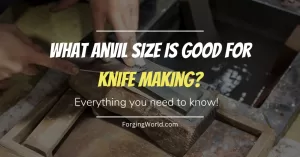Are you looking for some inspiration to get started with forging copper jewelry? Well, you’re in the right place!
In this blog post, we’ll explore some beginner-friendly copper jewelry forging projects that will help you create stunning pieces while learning valuable skills.
So, let’s heat up that forge and start crafting some beautiful jewelry!
Why Choose Copper for Jewelry Forging?
Copper is an excellent choice for beginners because it’s soft, malleable, and has a relatively low melting point compared to other metals. This makes it easy to shape and work with as you learn the basics of forging. Plus, copper has a unique, warm color that looks great in various jewelry pieces.
If you’re just starting out, we recommend checking out our guide on how to forge copper for a step-by-step tutorial.
Beginner-Friendly Copper Jewelry Projects
1. Copper Bangles
Copper bangles are a simple yet elegant project that will help you practice shaping and forming metal.
To create a bangle, you’ll need to cut a flat strip of copper, heat it in the forge, and then use a hammer and anvil to shape it.
Once you’ve formed the bangle into a circular shape, you can join the ends either by soldering or by creating a small overlap.
Customize Your Bangle:
- Add texture using different hammers, like a ball-peen or cross-peen hammer, to create interesting patterns.
- Use metal stamps to add letters, numbers, or symbols to your bangle.
- Experiment with various thicknesses and widths of copper strips to create different styles.
2. Copper Earrings
Earrings are a fantastic way to experiment with various shapes, textures, and designs.
Start with simple shapes like circles, squares, or teardrops, and as you gain confidence, try more intricate designs like spirals or leaves.
Creating Different Earring Styles:
- Dangle earrings: Forge small copper pieces and attach them to earring hooks using jump rings.
- Stud earrings: Solder a small post to the back of your design and secure it with a butterfly clutch.
- Hoop earrings: Create a circular or oval shape and attach a wire loop to slide through the ear.
3. Copper Pendants
Pendants allow for a wide range of creativity and can be as simple or complex as you like.
Start by forging a basic shape, such as a circle, square, or heart. Then, add texture or details with your hammer, chisels, or metal stamps.
Design Ideas:
- Create nature-inspired designs like leaves, flowers, or tree silhouettes.
- Incorporate gemstones or beads into your pendant design.
- Experiment with layering multiple copper pieces to create depth and dimension.
Don’t forget to forge a small loop at the top of your pendant to attach it to a chain or cord.
4. Copper Rings
Rings are a great project for practicing sizing and forming metal around a ring mandrel.
Start with a simple band and, as you become more comfortable with forging, experiment with adding decorative elements or gemstone settings.
Ring Design Tips:
- Add texture or patterns using hammers, stamps, or chisels.
- Create a stacking ring set by forging multiple rings with different textures or designs.
- Experiment with different band widths and thicknesses for various styles.
5. Copper Hairpins
Hairpins are a unique and functional piece of jewelry that you can create using your forging skills.
Forge a simple hairpin shape by shaping a copper wire into a U-shape or a hairpin with a loop at the top. Then, add decorative elements like spirals, leaves, or flowers to the top.
Hairpin Customization:
- Create various sizes and shapes of hairpins for different hair types and styles.
- Combine copper with other materials, such as beads or gemstones, to add color and interest.
- Use patinas to create different colors and finishes on your hairpins.
Tips and Advice for Forging Copper Jewelry
Start Small: Master the Basics
Choose simple designs to begin with, and gradually increase complexity as you gain experience and confidence.
Mastering the fundamentals of forging, such as heating, hammering, and shaping, will provide a strong foundation for more intricate projects down the line.
Patina Possibilities: Enhance Your Designs
Copper develops a natural patina over time, which can add character to your pieces. However, you can also create your own patinas using various techniques like applying liver of sulfur, ammonia, or vinegar solutions.
Experimenting with patinas can add depth, texture, and color to your copper jewelry. Check out our guide on how to create copper patinas for some inspiration.
Safety First: Protect Yourself and Your Workspace
Always prioritize safety when forging. Wear proper protective gear like gloves, safety glasses, and heat-resistant aprons.
Make sure your workspace is well-ventilated, and keep a fire extinguisher handy in case of emergencies.
Additionally, ensure that your tools and equipment are in good condition and used correctly.
Learn from Mistakes: Embrace the Process
Mistakes are part of the learning process, and they can provide valuable lessons for improvement.
Our article on copper forging mistakes will help you identify common errors and learn how to avoid them. Remember, patience and persistence are key to mastering any new skill.
Find Your Style: Develop a Signature Look
As you progress in your forging journey, experiment with different textures, shapes, and designs to develop your unique style.
Drawing inspiration from other artists, nature, or even your own imagination can help you create one-of-a-kind pieces that reflect your personality and taste.
Expand Your Knowledge: Learn from Others
There’s always more to learn in the world of forging. Attend workshops, watch online tutorials, or join blacksmithing communities to expand your knowledge and learn new techniques.
Connecting with other artists and enthusiasts can provide valuable insights, support, and inspiration.
Practice Makes Perfect: Hone Your Skills
Like any craft, forging requires practice to become proficient. Set aside time regularly to work on your projects and refine your skills.
As you gain experience, you’ll develop muscle memory, and your forging techniques will become more fluid and precise.
With these tips and advice in mind, you’re ready to embark on your copper jewelry forging journey. Enjoy the process, learn from your experiences, and, most importantly, have fun creating beautiful, unique pieces!
Final Thoughts
Now that you have more information on these beginner-friendly copper jewelry projects, it’s time to heat up the forge and get started!
Remember to be patient, practice, and most importantly, have fun as you learn and grow in your forging journey.


